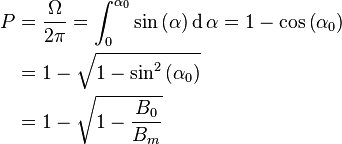Pitch angle (particle motion)
The pitch angle of a charged particle is the angle between the particle's velocity vector and the local magnetic field. This is a common measurement and topic when studying the magnetosphere, magnetic mirrors, ciconic cusps and polywells. See Aurora and Ring current
Usage: particle motion
It is customary to discuss the direction a particle is heading by its pitch angle. A pitch angle of 0 degrees is a particle whose parallel motion is perfectly along the local magnetic field. In the northern hemisphere this particle would be heading down toward the Earth (and the opposite in the southern hemisphere). A pitch angle of 90 degrees is a particle that is locally mirroring (see: Magnetosphere particle motion).
Special case: equatorial pitch angle
The equatorial pitch angle of a particle is the pitch angle of the particle at the Earth's geomagnetic equator. This angle defines the loss cone of a particle. The loss cone is the set of angles where the particle will strike the atmosphere and no longer be trapped in the magnetosphere while particles with pitch angles outside the loss cone will continue to be trapped. The loss cone is defined as the probability of particle loss from the magnetic bottle which is:
Where  is the solid angle we are concerned with,
is the solid angle we are concerned with,  is the equatorial pitch angle of the particle,
is the equatorial pitch angle of the particle,  is the equatorial magnetic field strength, and
is the equatorial magnetic field strength, and  is the maximum field strength. Notice that this is independent of charge, mass, or kinetic energy.
is the maximum field strength. Notice that this is independent of charge, mass, or kinetic energy.
The last line in the above derivation is due to the invariance of the invariance of the magnetic moment  at the point of reflection:
at the point of reflection:
thus


